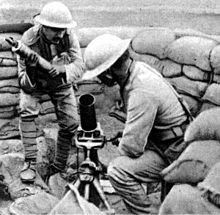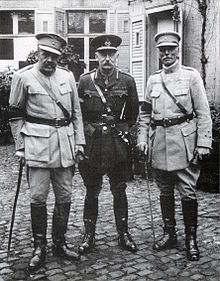Portuguese Expeditionary Force

The Portuguese Expeditionary Corps (Corpo Expedicionário Português) was the main Portuguese military association that took part in the First World War .
Portugal declared its neutrality at the beginning of the First World War . However, there were occasional skirmishes between Portuguese and German colonial troops in Africa, for example in the battle for Naulila . When the Portuguese government complied with an Allied request to confiscate German ships in Portugal, the German Reich declared war on Portugal in 1916. Portugal then set up an expeditionary force with nominally around 55,000 soldiers.
The temporarily up to 56,500 men were placed under the command of the British and deployed on the front in Flanders in the area between Laventie and Festubert . The headquarters of the corps moved to the La Peylouse country estate in Saint-Venant .
background

The Republic of Portugal , founded after the revolution of 1910, promised Great Britain material support and the dispatch of Portuguese troops as early as August 1914 . The Portuguese government justified its participation in the war with an old alliance agreement between the two countries, which was renewed in 1912. Portugal remained neutral until 1916, although there were occasional skirmishes between Portuguese and German colonial forces in Africa.
By taking part in the First World War on the side of the Allies, Portugal tried to protect its colonies. In 1898, the British Empire and the German Empire decided in the Angola Treaty to distribute Portuguese colonial property if Portugal could not pay its debts. In addition, Portugal wanted to underline its entry into the ranks of the leading European nations. Participation at the international level was perceived as a means of strengthening national unity. The legitimacy of the republican regime, which at the time was threatened by monarchist movements and great economic difficulties, was also to be strengthened. Growing logistical problems of the Allies led Great Britain to request the confiscation of all German ships anchored in Portuguese ports in December 1915. The Portuguese government did this on February 24, 1916, whereupon the German Reich declared war on Portugal on March 9.
The government announced that it would set up an expeditionary force to take part in the fight against the Western Front and set up the first units by July.
At the beginning of 1917 the corps was divided into two parts:
- Corpo Expedicionário Português (CEP) and
- Corpo de Artilharia Pesada Independente (CAPI) = independent corps of heavy artillery
General Tamagnini de Abreu was in command of the corps; General Gomes da Costa (1863-1929) was in command of the second division.
At the frontline

The Portuguese Expeditionary Corps landed in the Breton port city of Brest in February 1917 , was stationed in Aire-sur-la-Lys in the Pas-de-Calais department and incorporated into the 11th Corps of the British 1st Army under Commander-in-Chief General Henry Horne . There the first groups received training in trench warfare and were armed with British handguns. The first units were deployed in May; one sector of the front line was held full by the Portuguese Expeditionary Force in November; By the end of October almost 60,000 soldiers had been sent to France. Morale was low through the winter of 1917/18, partly because of the bad weather and partly because the soldiers saw no reason for themselves to be in France.
“In December 1917, the Portuguese government was overthrown in a coup and Sidónio Pais was declared president. The new government questioned the Portuguese support of the Allies and relaxed the regulations regarding home leave , which the soldiers gladly made use of. As a result, the corps had fewer and fewer officers to lead the troops. Sending new troops from Portugal to Flanders also became increasingly difficult, as Great Britain used its entire fleet to transport American soldiers when the United States entered the war in April 1917. As a result, there were more and more cases of refusal to obey in the Portuguese corps. "
A major problem was a gradual loss of soldiers: by April 1918 there were about 10% casualties from the war of attrition ; almost half of the officers were missing. There were no replacements, many units were severely understaffed; Soldiers were routinely denied vacations, and units were held in the front row for up to six months without a break. Morale fell sharply. Mutinies among the men were reported in April 1918 and the decision was made to withdraw the CEP from the front lines and replace them with British units.
On April 6, 1918, the 1st Division was withdrawn, the British 55th (West Lancashire) Division expanded their lines to the south and partially filled the gap and the Portuguese 2nd Division occupied the other part of the gap.
The 2nd Division now held twice the normal area of the front; it was planned to withdraw it on April 9th and replace it with two British divisions. That morning, however, the Germans launched a major attack on this section of the front, from which the Fourth Battle of Flanders (= Battle of the Lys; until April 29) developed. Eight German divisions - around 100,000 men - fought against 20,000 Portuguese. Despite stubborn resistance, the Portuguese were quickly overrun: the 4th Brigade (the defense of the northern sector) at 11 a.m., the 5th Brigade in the central sector at 1 p.m. Most of the 2nd Division disbanded and fled; the divisional staff had to be relocated twice on April 9.
The reserve , the British XI. Corps was deployed to support the remaining units. It joined two Portuguese battalions at the southern end of the line, which held their grounds until the next morning, and prevented further German advances south or south-west. The main void was filled by the British 50th (Northumbrian) Division and 51st (Highland) Division . The Portuguese Expeditionary Corps had 400 dead and around 6,500 prisoners on April 9, and together they lost a third of their troops at the front.
British forces in a similar position had been overrun just as quickly during Operation Michael the previous month .
What was left of the Portuguese Expeditionary Force was withdrawn behind the front in order to take over pioneering and security tasks at the rear. The 1st Division was later transferred to the front again for a short period of time.
At the time of the armistice (late 1918) the Portuguese Expeditionary Corps counted around 14,000 casualties: 2,160 dead, 5,224 wounded and 6,678 prisoners.
Commemoration

Near the Indian monument of Neuve-Chapelle is the Portuguese military cemetery of Richebourg . 1,831 soldiers rest at this only memorial for the Portuguese nation's efforts in World War I.
140 Portuguese lie in the large military cemetery at Boulogne-sur-Mer .
In 1928, in La Couture , the Portuguese and French governments dedicated a memorial to the soldiers who valiantly defended the community.
literature
- Luís Alves de Fraga: A Participação de Portugal na Grande Guerra . In: João Medina (ed.): História contemporânea de Portugal , Volume 1: Primeira república. Da conspiração republicana ao fim do regime parliamentar . Amigos do Livro, Lisboa 1985, Part 2, pp. 34-53.
- Basil H. Liddell Hart : History of the First World War . Macmillan, London 1992, ISBN 0-333-58261-6 .
Web links
- Grande Guerre: Les effectifs et les pertes du corps expéditionnaire portugais en France (staff numbers and losses)
- Hugo Rodrigues: Portugal in the Great War
Individual evidence
- ↑ a b c Richebourg Portuguese cemetery
- ↑ The Portuguese army used the Mauser-Vergueiro rifle (6.5 mm cartridge). It was believed that the ammunition supply for this could cause logistical problems; therefore the units received the British Lee-Enfield .
- ↑ a b c d e f Rodrigues
- ↑ The Portuguese in the First World War
- ↑ Liddell Hart, p. 402
- ^ Liddell Hart , p. 404
- ^ Boulogne sur mer, Boulogne Eastern Cemetery

